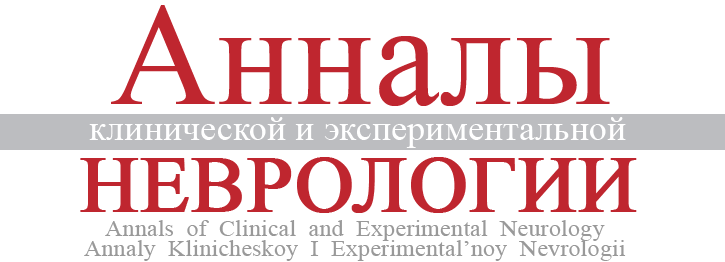Submissions
Online Submissions
Already have a Username/Password for Annals of Clinical and Experimental Neurology?
Go to Login
Need a Username/Password?
Go to Registration
Registration and login are required for submitting items online, and for checking the status of current submissions.
Submission Preparation Checklist
As part of the submission process, authors are required to check off their submission's compliance with each of the following items, and submissions that do not adhere to these guidelines may be returned to the authors.
Absence of plagiarism. The authors guarantee that this article has not been published in whole or in part, and is not under consideration or in the process of publication in another publication.
Correct manuscript format. Manuscript file format is Microsoft Word (has the extension *.doc, *.docx, *.rtf). The text adheres to the stylistic and bibliographic requirements outlined in the Author Guidelines.
Structure. Abstract is designed in accordance with the requirements and do not exceed the limit.
Illustrations. Tables and figures were placed within the text of the manuscript and have their titles.
Bibliography. The list of references is formatted in accordance with the requirements. All the cited sources were checked for DOI.
Supplementary files. The authors have prepared for transfer to the editor:
- file containing full information about the authors (Surname, first name, place of work, e-mail address);
- graphic files (photos, satellite images, graphics, etc.).
- the authors are ready to upload these files to the journal website in Step 4 during the manuscript submission process.
Authorship. The authors confirm that:
- all participants who have made a significant contribution to the study are presented as co-Authors;
- those who did not participate in the study are not listed as co-Authors;
- all co-Authors have seen and approved the final version of the work and agreed to submit it for publication.
Copyright Notice
Authors who publish with this journal agree to the following terms:
- Authors retain copyright and grant the Publisher right of first publication with the work simultaneously licensed under a Creative Commons Attribution 4.0 International Licensee (CC BY 4.0) that allows others to share the work with an acknowledgement of the work's authorship and initial publication in this journal.
- Authors are able to enter into separate, additional contractual arrangements for the non-exclusive distribution of the journal's published version of the work (e.g., post it to an institutional repository or publish it in a book), with an acknowledgement of its initial publication in this journal.
- Authors are permitted and encouraged to post their work online (e.g., in institutional repositories or on their website) prior to and during the submission process, as it can lead to productive exchanges, as well as earlier and greater citation of published work (See The Effect of Open Access).
All the Copyright statements for authors are present in the standart Publishing Agreement (Public Offer) to Publish an Article in an Academic Periodical 'Annals of Clinical and Experimental Neurology'.
- DOWNLOAD the print-version of the License Agreement.
READ the details online (tap to see in details)
Publishing Agreement (Public Offer) to Publish an Article in an Academic Periodical 'Annals of Clinical and Experimental Neurology'
License to use a Manuscript
The Author hereby grants Publisher of Annals of Clinical and Experimental Neurology journal (the ‘Journal’) a non-exclusive license to use, reproduce, distribute and publish the aforementioned Manuscript, metadata of the Manuscript and any other supplemental materials submitted as part of the Manuscript, including but not limited to tables, graphs, illustrations, research findings (the ‘Manuscript’) in any material form in print, electronic and all other media, in English, Russian and/or any other languages, with an unlimited number of copies, throughout the world, on an Open Access basis or by subscription, with no royalties, for the full term of the exclusive rights. The Publisher of the Annals of Clinical and Experimental Neurology journal is Research Center of Neurology.
Terms of publication
The Author has reviewed and hereby accepts the following terms of publication:
- The Editorial Board of the Journal are guided by the norms developed by the Committee on Publication Ethics (COPE) and the norms, specified in the Declaration of the Association of Scientific Editors and Publishers ‘Ethical Principles of Scientific Publications’.
- The publication of Manuscripts in Annals of Clinical and Experimental Neurology is free of charge.
- The Manuscript submitted to the Journal for publication has not been previously published and/or is not under consideration by any other journal or periodical.
- The Manuscript submitted to the Journal has been prepared in compliance with the Acceptance and Publication Rules of the Journal (the ‘Rules’). The Rules are available at https://annaly-nevrologii.com/
- All Manuscripts submitted to the Journal are peer reviewed.
- The editorial staff of the Journal is entitled to carry out technical, scientific and literary editing of the Manuscript so that its content remains unchanged. All changes relating to the scientific component of the Manuscript and/or its content are to be agreed with the Author.
- The editorial staff represented by the Editor-in-chief and/or Editorial Executive Board of the Journal have the right not to accept the Manuscript for publication in cases, including but not limited to the Manuscript not corresponding to the topics covered by the Journal or any part of it, or if the submitted materials are deemed insufficient for a separate publication, the design of the Manuscript does not correspond to the rules of the Journal, the norms of publication ethics have been violated by the Author or if illegal borrowings or duplicate publications have been revealed.
- The Manuscript is accepted for publication by the Editor-in-chief, following the recommendations of the reviewer and the Editorial Board.
- The Manuscript accepted for publication will be published in the Journal in accordance with the terms of the Creative Commons Attribution 4.0 International license (СС-BY). The CC-BY license allows users to copy and distribute materials in all forms and across all media, and to create materials derived from the original material for any purposes, including for commercial purposes. The full details of the CC-BY license are available at: https://creativecommons.org/licenses/by/4.0/legalcode
- After the Manuscript has been published in the Journal the Author has the right to publish the Manuscript in other periodicals. The Author shall indicate that the Manuscript was first published in the Journal with obligatory reference to the number, month, year of publication and link to the formal publication (through the relevant DOI).
Guarantees of the Author
The Author guarantees that:
- he/she is the legitimate copyright holder of the article; the rights granted to the Journal under this Agreement have not been transferred and will not be transferred to third parties before the publication of the Manuscript in the Journal;
- the Manuscript contains all the references to cited authors and/or sources (materials) in accordance with the copyright law of the Russian Federation and/or legislation of the country of the Author’s citizenship (residence);
- the Author has received all the required licenses (permissions) to use results, facts and other borrowed content in the article, should the Author not be the copyright holder;
- at the time of submission of the Manuscript to the Journal, the rights to use the Manuscript will not have been transferred to third parties and the Manuscript will not have been published in any other journal and/or periodical;
- the Manuscript does not contain materials which are not liable for publication in open sources, in line with the normative legal acts of the Russian Federation or any other country of the Author’s citizenship (residence) and the publication and distribution of the article will not lead to the disclosure of secret (confidential) information, including state secrets;
- the Author has obtained all consents in accordance with the legislation of the Russian Federation and/or the country of the Author’s citizenship (residence) in terms of the use of personal data and/or images of patients, research subjects and other persons;
- the Author has informed the co-authors of the terms of this Agreement and obtained consents from all co-authors to sign this Agreement according to the specified conditions.
Other conditions
- The interaction, correspondence and transmission of materials and information is permitted by any communication method, available to both the Author and the Journal, with priority given to the online management editorial system on the Journal website and, including but not limited to, postal items, courier services, express delivery services, email and instant messaging systems (client programmes for online messaging). The scanned copies of original documents, transmitted by means of the aforementioned communication methods, are effective as originals for all Parties until the originals are exchanged.
- This Agreement shall be construed in accordance with the legislation of the Russian Federation. All disputes that may arise under this Agreement shall be settled in accordance with the standard business practices and legislation of the Russian Federation.
Registered Address and Particulars of the Publisher
Research Center of Neurology
Address: 80, Volokolamskoye shosse, Moscow, 125367
E-mail: center@neurology.ru
Phone: +7 (495) 374-77-76
Privacy Statement
The Editorial Board of the journal and the administration of the website of the journal do not transfer personal information in any way specified by the users when working with the website of the journal to third parties, except for those cases and to the extent specified in the terms of the copyright agreement.
The affiliation work and e-mail address of the authors of the manuscript accepted for publication will be published in the section "information about the authors" of the printed version of the journal and in the section "about the authors" on the page of the article on the website of the journal.
The phone number of the corresponding author will be known only to the editorial Board Secretariat and will only be used in cases of emergency.





